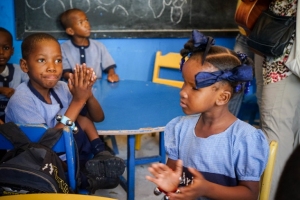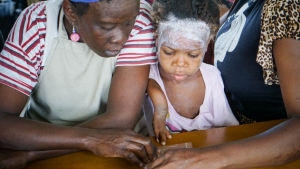New Site, New Life for St. Vincent’s Center in Haiti
In this Easter season, there are many reasons to celebrate the victory of life over death at St. Vincent’s Center in Port-au-Prince, Haiti, where children with disabilities receive education, medical care, love and hope.
After devastating losses to life and property in the 2010 earthquake, and seven long years in temporary quarters, St. Vincent’s moved into a new school in September 2017. For the 200 deaf, blind and physically disabled children attending the school, the new 8 ½ acre property on one floor was a blessing beyond imagining — no more steps to climb or broken elevators to work around, but rather acres of room to walk, run, wheel and stroll into one-story, accessible buildings.
The property includes a large house that has been renovated to provide space for dormitories and administration. In addition, a kitchen, library and 17 accessible classrooms have been built. St. Vincent’s first principal, Irvika Francois, recently joined the staff and is evaluating the curriculum and introducing new, innovative ways of teaching disabled children. The buildings and grounds position has just been filled with a graduate of the Holy Trinity Cathedral’s Professional School, who brings skills in plumbing and electricity. These two recent staff additions round out a leadership team that includes the School’s Administrator, Aurelie Fièvre, and the Rev. Frantz Cole, Chaplain and Director of Partnerships.
The Center’s board is also new. Formed in April 2016 by Bishop Jean-Zaché Duracin, and currently made up of seven U.S. members and eight Haitian members, the board is charged with creating a strategic plan, setting policies and providing oversight for the Center’s operations.
Serving Haiti since 1945
When Sister Joan Margaret, a physical therapist and a nun in the Episcopal Society of St. Margaret, joined her sisters in Haiti in 1944, there were no services for children with disabilities. She opened a day nursery, La Creche, for children under five who were blind, deaf or physically disabled. The need was great and the ministry grew quickly. It was not long before it was moved to larger quarters and the name was changed to St. Vincent’s Centre for Handicapped Children. Over time, a brace shop for making and fitting prosthetics and a medical clinic were added to the school’s services and made available to those outside the school as well as the students.
Often described as indomitable, Sister Joan worked tirelessly in the decades that followed to promote the school and help St. Vincent’s children “be all they could be.” Her efforts to share St. Vincent’s story and raise funds established relationships with U.S. Episcopal congregations, dioceses and schools as well as medical organizations. Sister Joan remained in Haiti until three years before her death in 2006 at the age of 99.
A promising new beginning
Elizabeth Lowell, a board member and chair of the Development Committee, returned from the April board meeting in Haiti encouraged by what she experienced. “I see so much good that’s happening in Haiti,” she says.
 She is seeing less poverty than on her first visit 20 years ago. And the government is stepping up, providing three buses that take St. Vincent’s day students living in Port-au-Prince to and from the campus every weekday. A Ministry of Inclusion has been established, headed by Gérald Oriol Jr., Secretary of State for the Integration of Persons with Disabilities. “These are basic steps forward,” she says, “and mean that a foundation is being built.”
She is seeing less poverty than on her first visit 20 years ago. And the government is stepping up, providing three buses that take St. Vincent’s day students living in Port-au-Prince to and from the campus every weekday. A Ministry of Inclusion has been established, headed by Gérald Oriol Jr., Secretary of State for the Integration of Persons with Disabilities. “These are basic steps forward,” she says, “and mean that a foundation is being built.”
“Right now, St. Vincent’s is a startup organization in many ways,” she says. “Not only because of the new board, but also because of the new property.” With an operating budget of half a million each year, it is important that operating expenses do not outstrip cash flow. To address the need for additional revenue, last year the Board introduced its “Tuition Gap” Program. Tuition per student comes to $780 per year, a portion of the annual cost to run the school. Families of the students are asked to pay $130 per year, a large sum by Haitian standards. Thus the “gap” of $650. In the first year some 60 tuition gap sponsors stepped forward. This year the goal is 200.
The new school has a great deal of undeveloped land and many plans for the future. “We want to landscape the property with fruit-bearing trees, raise vegetables, grow aromatic plants that blind students can enjoy and make the grounds beautiful and productive,” says Elizabeth.
More immediate needs include two playgrounds, as there are none at present, and a soccer field, surrounded by a track. Children with disabilities can enjoy the sports that all children enjoy. A ball with a bell enables visually impaired children to play soccer, and a guide rope can help them use the track. There is also an urgent need to purchase a pickup truck for food and supplies and a replacement for the school’s 17-passenger, wheelchair accessible van.
St. Vincent’s endowment, a commitment that endures
Sometimes, what begins as a simple response to a need grows into an enduring commitment.
In 1994, following visits by interested individuals and building on the Companion Diocese relationship between the Diocese of East Tennessee and Haiti, a new non-profit organization was formed to build lasting support for St. Vincent’s. It was called the Children’s Medical Mission of Haiti (CMMH). The late Bishop Robert Tharp, of East Tennessee, was the organization’s first president.
 From the beginning, CMMH emphasized the importance of forming and growing an endowment fund. Today, there is about $1.3 million in the fund, now managed by the Episcopal Church Foundation’s Endowment Management Solutions (EMS) program. Recently CMMH and the St. Vincent’s Board were merged into one non-profit organization.
From the beginning, CMMH emphasized the importance of forming and growing an endowment fund. Today, there is about $1.3 million in the fund, now managed by the Episcopal Church Foundation’s Endowment Management Solutions (EMS) program. Recently CMMH and the St. Vincent’s Board were merged into one non-profit organization.
“The endowment has been the lifeblood of this institution for many years,” says Ken Quigley, Senior Program Director for EMS at ECF. “It’s the base that keeps things going when fundraising gets hard. We manage it carefully while encouraging new gifts.
“Following the earthquake we had a large influx of donations for current operations, so we did not need to draw anything from the endowment for several years. In time, to meet current operating needs, we had to tap into its resources. We tried to maintain a discipline of drawing down only a prudent amount each year — normally 5% of a rolling three-year average. But because donations vary throughout the year, the endowment has also been used as a line of credit — spending more in the early part of the year, then replacing the overage plus interest in the latter part of the year when most donations are received. This reliable, monthly wire has kept the school in business.”
The endowment also played a significant role in building the new school at Santo 17. “The CMMH board committed $100,000, over and apart from the annual draw,” says Ken. “This was matched by Episcopal Relief and Development (ERD) and supplemented by funds from the Episcopal Church. Together we were able assemble sufficient funds to build the new school.”
Looking ahead
Ken sees St. Vincent’s move to Santo 17 as step one in a much larger transition. With dormitory space, the school can expand to serve residential students as well as day students. This is especially critical for disabled children living outside of Port-au-Prince.
Also, the Board has placed a new emphasis on education, developing an individualized plan for its students from day one, so that each child is prepared to live as independently as possible upon graduation.
It was Sister Joan’s dream that “handicapped people can lead normal lives,” said SMS sister Marjorie Raphael in the Boston Globe’s January 4, 2006, obituary for St. Vincent’s founder. And so it is that the work she began continues to grow, bringing hope where there was despair and new life to Haitian children with disabilities.
Susan Elliott is a writer and editor, working with the Episcopal Church Foundation, Forward Movement, RenewalWorks, and parishes and other organizations in the Episcopal Church. She is the writer of ECF’s 2015 Vestry Resource Guide, and collaborates with Jay Sidebotham on “Slow Down. Quiet. It’s Advent,” published annually by Forward Movement.